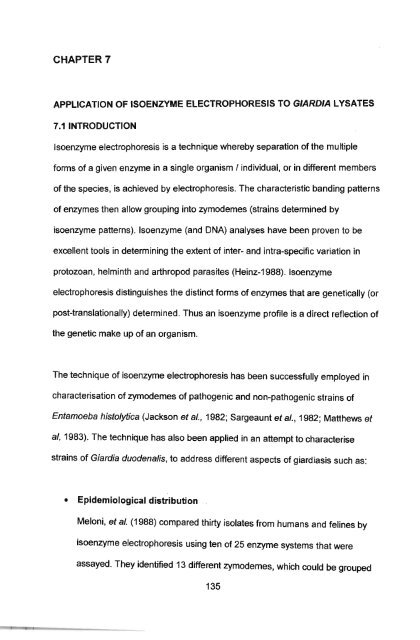in vitro culture and isoenzyme analysis of giardia lamblia
in vitro culture and isoenzyme analysis of giardia lamblia
in vitro culture and isoenzyme analysis of giardia lamblia
You also want an ePaper? Increase the reach of your titles
YUMPU automatically turns print PDFs into web optimized ePapers that Google loves.
CHAPTER 7<br />
APPLICATION OF ISOENZYME ELECTROPHORESIS TO GIARDIA L YSATES<br />
7.1 INTRODUCTION<br />
Isoenzyme electrophoresis is a technique whereby separation <strong>of</strong> the multiple<br />
forms <strong>of</strong> a given enzyme <strong>in</strong> a s<strong>in</strong>gle organism I <strong>in</strong>dividual, or <strong>in</strong> different members<br />
<strong>of</strong> the species, is achieved by electrophoresis. The characteristic b<strong>and</strong><strong>in</strong>g patterns<br />
<strong>of</strong> enzymes then allow group<strong>in</strong>g <strong>in</strong>to zymodemes (stra<strong>in</strong>s determ<strong>in</strong>ed by<br />
<strong>isoenzyme</strong> patterns). Isoenzyme (<strong>and</strong> DNA) analyses have been proven to be<br />
excellent tools <strong>in</strong> determ<strong>in</strong><strong>in</strong>g the extent <strong>of</strong> <strong>in</strong>ter- <strong>and</strong> <strong>in</strong>tra-specific variation <strong>in</strong><br />
protozoan, helm<strong>in</strong>th <strong>and</strong> arthropod parasites (He<strong>in</strong>z-1988). Isoenzyme<br />
electrophoresis dist<strong>in</strong>guishes the dist<strong>in</strong>ct forms <strong>of</strong> enzymes that are genetically (or<br />
post-translationally) determ<strong>in</strong>ed. Thus an <strong>isoenzyme</strong> pr<strong>of</strong>ile is a direct reflection <strong>of</strong><br />
the genetic make up <strong>of</strong> an organism.<br />
The technique <strong>of</strong> <strong>isoenzyme</strong> electrophoresis has been successfully employed <strong>in</strong><br />
characterisation <strong>of</strong> zymodemes <strong>of</strong> pathogenic <strong>and</strong> non-pathogenic stra<strong>in</strong>s <strong>of</strong><br />
Entamoeba histolytica (Jackson et al., 1982; Sargeaunt et al., 1982; Matthews et<br />
aI, 1983). The technique has also been applied <strong>in</strong> an attempt to characterise<br />
stra<strong>in</strong>s <strong>of</strong> Giardia duodenalis, to address different aspects <strong>of</strong> <strong>giardia</strong>sis such as:<br />
• Epidemiological distribution<br />
Meloni, et al. (1988) compared thirty isolates from humans <strong>and</strong> fel<strong>in</strong>es by<br />
<strong>isoenzyme</strong> electrophoresis us<strong>in</strong>g ten <strong>of</strong> 25 enzyme systems that were<br />
assayed. They identified 13 different zymodemes, which could be grouped<br />
135
















